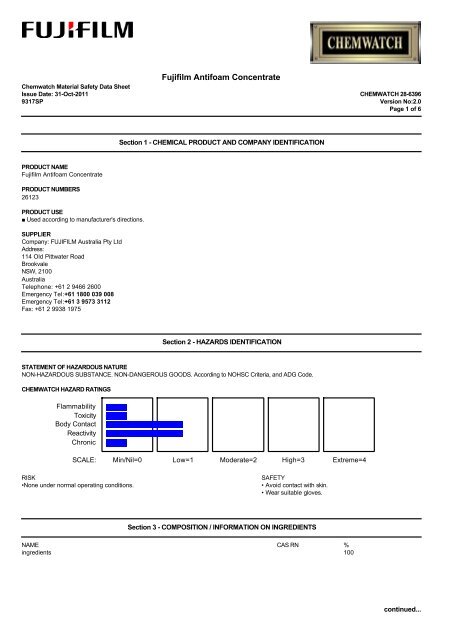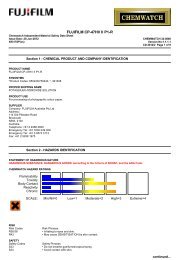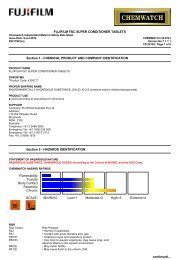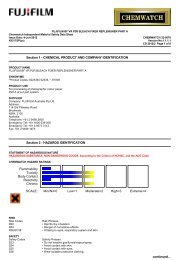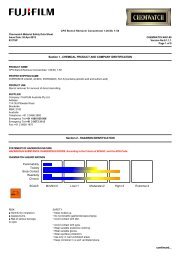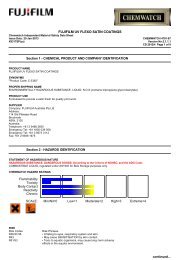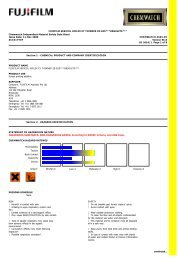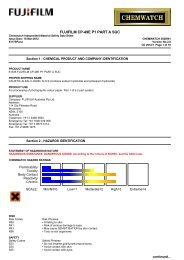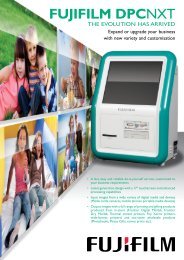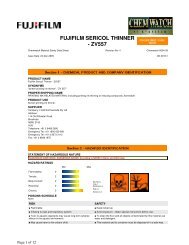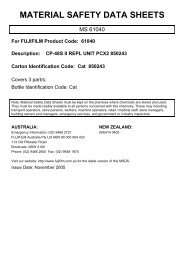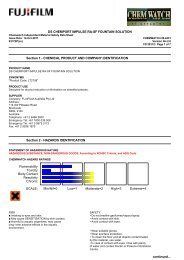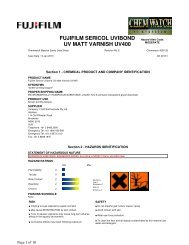anti foam concentrate - FUJIFILM Australia
anti foam concentrate - FUJIFILM Australia
anti foam concentrate - FUJIFILM Australia
You also want an ePaper? Increase the reach of your titles
YUMPU automatically turns print PDFs into web optimized ePapers that Google loves.
Fujifilm Anti<strong>foam</strong> Concentrate<br />
Chemwatch Material Safety Data Sheet<br />
Issue Date: 31-Oct-2011 CHEMWATCH 28-6396<br />
9317SP<br />
Version No:2.0<br />
Page 1 of 6<br />
Section 1 - CHEMICAL PRODUCT AND COMPANY IDENTIFICATION<br />
PRODUCT NAME<br />
Fujifilm Anti<strong>foam</strong> Concentrate<br />
PRODUCT NUMBERS<br />
26123<br />
PRODUCT USE<br />
■ Used according to manufacturer's directions.<br />
SUPPLIER<br />
Company: <strong>FUJIFILM</strong> <strong>Australia</strong> Pty Ltd<br />
Address:<br />
114 Old Pittwater Road<br />
Brookvale<br />
NSW, 2100<br />
<strong>Australia</strong><br />
Telephone: +61 2 9466 2600<br />
Emergency Tel:+61 1800 039 008<br />
Emergency Tel:+61 3 9573 3112<br />
Fax: +61 2 9938 1975<br />
Section 2 - HAZARDS IDENTIFICATION<br />
STATEMENT OF HAZARDOUS NATURE<br />
NON-HAZARDOUS SUBSTANCE. NON-DANGEROUS GOODS. According to NOHSC Criteria, and ADG Code.<br />
CHEMWATCH HAZARD RATINGS<br />
Flammability<br />
Toxicity<br />
Body Contact<br />
Reactivity<br />
Chronic<br />
SCALE: Min/Nil=0 Low=1 Moderate=2 High=3 Extreme=4<br />
RISK<br />
•None under normal operating conditions.<br />
SAFETY<br />
• Avoid contact with skin.<br />
• Wear suitable gloves.<br />
Section 3 - COMPOSITION / INFORMATION ON INGREDIENTS<br />
NAME CAS RN %<br />
ingredients 100<br />
continued...
Fujifilm Anti<strong>foam</strong> Concentrate<br />
Chemwatch Material Safety Data Sheet<br />
Issue Date: 31-Oct-2011 CHEMWATCH 28-6396<br />
9317SP<br />
Version No:2.0<br />
Page 2 of 6<br />
Section 4 - FIRST AID MEASURES<br />
SWALLOWED<br />
• Immediately give a glass of water.<br />
• First aid is not generally required. If in doubt, contact a Poisons Information Centre or a doctor.<br />
EYE<br />
■ If this product comes in contact with eyes:<br />
• Wash out immediately with water.<br />
• If irritation continues, seek medical attention.<br />
• Removal of contact lenses after an eye injury should only be undertaken by skilled personnel.<br />
SKIN<br />
■ If skin contact occurs:<br />
• Immediately remove all contaminated clothing, including footwear.<br />
• Flush skin and hair with running water (and soap if available).<br />
• Seek medical attention in event of irritation.<br />
INHALED<br />
• If fumes, aerosols or combustion products are inhaled remove from contaminated area.<br />
• Other measures are usually unnecessary.<br />
NOTES TO PHYSICIAN<br />
■ Treat symptomatically.<br />
Section 5 - FIRE FIGHTING MEASURES<br />
EXTINGUISHING MEDIA<br />
• There is no restriction on the type of extinguisher which may be used.<br />
• Use extinguishing media suitable for surrounding area.<br />
FIRE FIGHTING<br />
• Alert Fire Brigade and tell them location and nature of hazard.<br />
• Wear breathing apparatus plus protective gloves for fire only.<br />
• Prevent, by any means available, spillage from entering drains or water courses.<br />
• Use fire fighting procedures suitable for surrounding area.<br />
FIRE/EXPLOSION HAZARD<br />
• Non combustible.<br />
• Not considered a significant fire risk, however containers may burn.<br />
Decomposition may produce toxic fumes of: carbon dioxide (CO2), other pyrolysis products typical of burning organic material.<br />
May emit corrosive fumes.<br />
FIRE INCOMPATIBILITY<br />
• Avoid contamination with oxidising agents i.e. nitrates, oxidising acids, chlorine bleaches, pool chlorine etc. as ignition may<br />
result.<br />
HAZCHEM<br />
None<br />
Section 6 - ACCIDENTAL RELEASE MEASURES<br />
MINOR SPILLS<br />
• Clean up all spills immediately.<br />
• Avoid breathing vapours and contact with skin and eyes.<br />
• Control personal contact by using protective equipment.<br />
• Contain and absorb spill with sand, earth, inert material or vermiculite.<br />
MAJOR SPILLS<br />
■ Moderate hazard.<br />
• Clear area of personnel and move upwind.<br />
• Alert Fire Brigade and tell them location and nature of hazard.<br />
• Wear breathing apparatus plus protective gloves.<br />
continued...
Fujifilm Anti<strong>foam</strong> Concentrate<br />
Chemwatch Material Safety Data Sheet<br />
Issue Date: 31-Oct-2011 CHEMWATCH 28-6396<br />
9317SP<br />
Version No:2.0<br />
Page 3 of 6<br />
Section 6 - ACCIDENTAL RELEASE MEASURES<br />
• Prevent, by any means available, spillage from entering drains or water course.<br />
Personal Protective Equipment advice is contained in Section 8 of the MSDS.<br />
Section 7 - HANDLING AND STORAGE<br />
PROCEDURE FOR HANDLING<br />
• Avoid all personal contact, including inhalation.<br />
• Wear protective clothing when risk of exposure occurs.<br />
• Use in a well-ventilated area.<br />
• Avoid contact with moisture.<br />
• DO NOT allow clothing wet with material to stay in contact with skin.<br />
SUITABLE CONTAINER<br />
• Polyethylene or polypropylene container.<br />
• Packing as recommended by manufacturer.<br />
• Check all containers are clearly labelled and free from leaks.<br />
STORAGE INCOMPATIBILITY<br />
• Avoid reaction with oxidising agents.<br />
STORAGE REQUIREMENTS<br />
• Store in original containers.<br />
• Keep containers securely sealed.<br />
• Store in a cool, dry, well-ventilated area.<br />
• Store away from incompatible materials and foodstuff containers.<br />
Section 8 - EXPOSURE CONTROLS / PERSONAL PROTECTION<br />
EXPOSURE CONTROLS<br />
PERSONAL PROTECTION<br />
RESPIRATOR<br />
•Type A Filter of sufficient capacity. (AS/NZS 1716 & 1715, EN 143:2000 & 149:2001, ANSI Z88 or national equivalent)<br />
EYE<br />
• Safety glasses with side shields.<br />
• Chemical goggles.<br />
• Contact lenses may pose a special hazard; soft contact lenses may absorb and <strong>concentrate</strong> irritants. A written policy document,<br />
describing the wearing of lens or restrictions on use, should be created for each workplace or task. This should include a<br />
review of lens absorption and adsorption for the class of chemicals in use and an account of injury experience. Medical and<br />
first-aid personnel should be trained in their removal and suitable equipment should be readily available. In the event of<br />
chemical exposure, begin eye irrigation immediately and remove contact lens as soon as practicable. Lens should be removed at<br />
the first signs of eye redness or irritation - lens should be removed in a clean environment only after workers have washed<br />
hands thoroughly. [CDC NIOSH Current Intelligence Bulletin 59], [AS/NZS 1336 or national equivalent].<br />
HANDS/FEET<br />
• Wear chemical protective gloves, eg. PVC.<br />
• Wear safety footwear or safety gumboots, eg. Rubber.<br />
Suitability and durability of glove type is dependent on usage. Important factors in the selection of gloves include:<br />
• frequency and duration of contact,<br />
• chemical resistance of glove material,<br />
• glove thickness and<br />
• dexterity.<br />
continued...
Fujifilm Anti<strong>foam</strong> Concentrate<br />
Chemwatch Material Safety Data Sheet<br />
Issue Date: 31-Oct-2011 CHEMWATCH 28-6396<br />
9317SP<br />
Version No:2.0<br />
Page 4 of 6<br />
Section 8 - EXPOSURE CONTROLS / PERSONAL PROTECTION<br />
OTHER<br />
• Overalls.<br />
• P.V.C. apron.<br />
• Barrier cream.<br />
• Skin cleansing cream.<br />
ENGINEERING CONTROLS<br />
■ Engineering controls are used to remove a hazard or place a barrier between the worker and the hazard. Well-designed<br />
engineering controls can be highly effective in protecting workers and will typically be independent of worker interactions to<br />
provide this high level of protection.<br />
The basic types of engineering controls are:<br />
Process controls which involve changing the way a job activity or process is done to reduce the risk.<br />
Enclosure and/or isolation of emission source which keeps a selected hazard "physically" away from the worker and ventilation<br />
that strategically "adds" and "removes" air in the work environment.<br />
Section 9 - PHYSICAL AND CHEMICAL PROPERTIES<br />
APPEARANCE<br />
White liquid with mild odour; mixes with water.<br />
PHYSICAL PROPERTIES<br />
Liquid.<br />
Mixes with water.<br />
State Liquid Molecular Weight Not Applicable<br />
Melting Range (°C) Not Available Viscosity Not Available<br />
Boiling Range (°C) 100 Solubility in water (g/L) Miscible<br />
Flash Point (°C) Not Applicable pH (1% solution) Not Available<br />
Decomposition Temp (°C) Not Available pH (as supplied) Not Available<br />
Autoignition Temp (°C) Not Applicable Vapour Pressure (kPa) Not Available<br />
Upper Explosive Limit (%) Not Applicable Specific Gravity (water=1) 1.0<br />
Lower Explosive Limit (%) Not Applicable Relative Vapour Density Not Available<br />
(air=1)<br />
Volatile Component (%vol) 0 Evaporation Rate Not Available<br />
Section 10 - STABILITY AND REACTIVITY<br />
CONDITIONS CONTRIBUTING TO INSTABILITY<br />
• Presence of incompatible materials.<br />
• Product is considered stable.<br />
• Hazardous polymerisation will not occur.<br />
For incompatible materials - refer to Section 7 - Handling and Storage.<br />
Section 11 - TOXICOLOGICAL INFORMATION<br />
POTENTIAL HEALTH EFFECTS<br />
ACUTE HEALTH EFFECTS<br />
SWALLOWED<br />
■ Although ingestion is not thought to produce harmful effects (as classified under EC Directives), the material may still be<br />
damaging to the health of the individual, following ingestion, especially where pre-existing organ (e.g liver, kidney) damage is<br />
evident. Present definitions of harmful or toxic substances are generally based on doses producing mortality rather than those<br />
producing morbidity (disease, ill-health).<br />
EYE<br />
■ Although the material is not thought to be an irritant (as classified by EC Directives), direct contact with the eye may<br />
produce transient discomfort characterised by tearing or conjunctival redness (as with windburn).<br />
SKIN<br />
■ The material is not thought to produce adverse health effects or skin irritation following contact (as classified by EC<br />
Directives using animal models). Nevertheless, good hygiene practice requires that exposure be kept to a minimum and that<br />
continued...
Fujifilm Anti<strong>foam</strong> Concentrate<br />
Chemwatch Material Safety Data Sheet<br />
Issue Date: 31-Oct-2011 CHEMWATCH 28-6396<br />
9317SP<br />
Version No:2.0<br />
Page 5 of 6<br />
Section 11 - TOXICOLOGICAL INFORMATION<br />
suitable gloves be used in an occupational setting.<br />
INHALED<br />
■ The material is not thought to produce adverse health effects or irritation of the respiratory tract (as classified by EC<br />
Directives using animal models). Nevertheless, good hygiene practice requires that exposure be kept to a minimum and that<br />
suitable control measures be used in an occupational setting.<br />
CHRONIC HEALTH EFFECTS<br />
■ Long-term exposure to the product is not thought to produce chronic effects adverse to the health (as classified by EC<br />
Directives using animal models); nevertheless exposure by all routes should be minimised as a matter of course.<br />
TOXICITY AND IRRITATION<br />
■ Not available. Refer to individual constituents.<br />
Section 12 - ECOLOGICAL INFORMATION<br />
No data<br />
Ecotoxicity<br />
Ingredient Persistence: Persistence: Air Bioaccumulation Mobility<br />
Water/Soil<br />
Fujifilm Anti<strong>foam</strong> Concentrate No Data No Data<br />
Available<br />
Available<br />
Section 13 - DISPOSAL CONSIDERATIONS<br />
■ Legislation addressing waste disposal requirements may differ by country, state and/ or territory. Each user must refer to<br />
laws operating in their area.<br />
A Hierarchy of Controls seems to be common - the user should investigate:<br />
• Reduction.<br />
• DO NOT allow wash water from cleaning or process equipment to enter drains.<br />
• It may be necessary to collect all wash water for treatment before disposal.<br />
• In all cases disposal to sewer may be subject to local laws and regulations and these should be considered first.<br />
• Where in doubt contact the responsible authority.<br />
• Recycle wherever possible.<br />
• Consult manufacturer for recycling options or consult local or regional waste management authority for disposal if no suitable<br />
treatment or disposal facility can be identified.<br />
• Dispose of by: burial in a land-fill specifically licenced to accept chemical and / or pharmaceutical wastes or incineration in<br />
a licenced apparatus (after admixture with suitable combustible material).<br />
• Decontaminate empty containers. Observe all label safeguards until containers are cleaned and destroyed.<br />
Section 14 - TRANSPORTATION INFORMATION<br />
HAZCHEM:<br />
None (ADG7)<br />
NOT REGULATED FOR TRANSPORT OF DANGEROUS GOODS: UN, IATA, IMDG<br />
Section 15 - REGULATORY INFORMATION<br />
POISONS SCHEDULE None<br />
REGULATIONS<br />
Fujifilm Anti<strong>foam</strong> Concentrate<br />
continued...
Fujifilm Anti<strong>foam</strong> Concentrate<br />
Chemwatch Material Safety Data Sheet<br />
Issue Date: 31-Oct-2011 CHEMWATCH 28-6396<br />
9317SP<br />
Version No:2.0<br />
Page 6 of 6<br />
Section 15 - REGULATORY INFORMATION<br />
No data for Fujifilm Anti<strong>foam</strong> Concentrate (CW: 28-6396)<br />
Section 16 - OTHER INFORMATION<br />
■ Classification of the preparation and its individual components has drawn on official and authoritative sources as well as<br />
independent review by the Chemwatch Classification committee using available literature references.<br />
A list of reference resources used to assist the committee may be found at:<br />
www.chemwatch.net/references.<br />
■ The (M)SDS is a Hazard Communication tool and should be used to assist in the Risk Assessment. Many factors determine whether<br />
the reported Hazards are Risks in the workplace or other settings.<br />
This document is copyright. Apart from any fair dealing for the purposes of private study, research, review or<br />
criticism, as permitted under the Copyright Act, no part may be reproduced by any process without written<br />
permission from CHEMWATCH. TEL (+61 3) 9572 4700.<br />
Issue Date: 31-Oct-2011<br />
Print Date: 16-Nov-2011<br />
This is the end of the MSDS.


